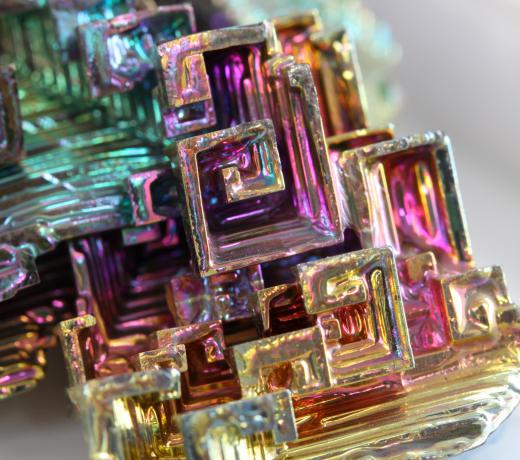What is Astatine?
 Mary McMahon
Mary McMahon
Astatine is a semimetallic chemical element classified among the halogens in the periodic table of elements. It is radioactive and extremely unstable, with a half-life of around eight hours. As a result of its instability, this element is incredibly rare; naturally, around 1 ounce (28 grams) of this element exists at any given time, making it the rarest naturally occurring element. It is also possible to create this element and several of its isotopes in a laboratory setting by bombarding bismuth with alpha particles.
Because astatine is so rare, it does not have any commercial uses. Consumers probably never interact with it, although scientists often do. Like other elements, it has been the subject of extensive research in lab settings because scientists are interested in learning more about all of the substances that can be found on Earth. Some researchers suspect that isotopes of the element could potentially be useful in medical imaging studies, especially astatine 211. The short life of this element makes it challenging to study, as it is difficult to get and it doesn't last long.

Naturally, the world's astatine is found in uranium ore. In a pure form, it appears to take on a solid state, and it seems to share many chemical properties with iodine, a closely related element. Researchers believe, for example, that astatine could accumulate in thyroid glands like iodine does. The element has an atomic number of 85, and it is identified on the periodic table of elements with the symbol At. It is the heaviest of the halogens.

The discovery of astatine was announced in 1931 by Fred Allison and E.J. Murphy. By 1940, a team of scientists in California had managed to create the 211 isotope; the credit for this discovery goes to D.R. Corson, K.R. Mackenzie, and Emilio Segré. The name of the element is derived from the Greek astatos, which means “unstable.”
Like other radioactive elements, astatine poses a human health risk. It can cause radiation damage to cells in people who are exposed to it without adequate protection. Fortunately, consumers do not generally need to worry about this danger because of its rarity, and in laboratories, the people who work with the element receive training in handling radioactive substances. Because it could collect in the thyroid gland, people who work with astatine are especially careful around it to ensure that they do not do long term damage to their bodies.
AS FEATURED ON:
AS FEATURED ON:













Discussion Comments
@stl156 - You're exactly right. None of the astatine that was present at Earth's creation is still here, but thinking about it in reverse will give you your answer.
Astatine in the soil decays and forms elements lower on the periodic table. If you go the other way, radioactive elements higher on the periodic table also decay and form astatine, but in very small amounts.
@cardsfan27 - I did a report in high school about astatine. It looks like things haven't advanced too far since then. From what I can remember, there wasn't a whole lot about it that was exciting. It is just a black lump.
Maybe since it is a halogen it has some exciting properties, but I'm not sure what they would be. I'm curious how hard it would be to turn astatine into a gas, and whether that would change how it acts.
What I'm really wondering now is that, if astatine is the rarest occurring element, and it breaks down after eight hours, how is it formed in the first place? I don't remember much from chemistry, but I know that somehow protons would have to come together to make the nucleus. All of the astatine around even last week should be gone by now, right? How does the new stuff form? Does it have something to do with the uranium?
@jcraig - I didn't know astatine had a potential use for medical imagining, but I do know one of the uses for astatine is in cancer radiation treatment. I'm not sure how often it is used, but I know it is common in prostate cancer treatments.
Does anyone know what the physical properties of astatine are? Does it have any interesting colors or other characteristics?
@anon149822 - Like the article mentions, when scientists need to study a rare element, they find ways to artificially create it. In this case, they use bismuth. Since elements are defined by their numbers of protons, once the element is produced, it has the same properties as the naturally occurring element.
I do think it is interesting to know that it is the rarest natural element. Since it doesn't last long in its natural form, how could scientists use it for medical imagining? Is there something special about astatine 211 that makes it more useful? Since it is radioactive, are there any more potential uses for it?
Astatine is such a rare substances, how can scientists have it at hand.
Post your comments